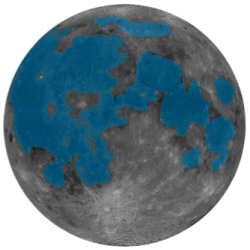Source Institutions
Source Institutions
Add to list Go to activity
Activity link broken? See if it's at the internet archive

In this activity, learners model how the Moon's volcanic period reshaped its earlier features. Learners consider that the broad, shallow impact basins--which had formed earlier while it was a "kid Moon"--contained cracks through which magma seeped up. A plate in which slits have been cut is used to represent an impact basin and a dish of red-colored water is used to represent the pockets of magma within the Moon's upper layers. When the model impact basin is pressed into the magma, "lava" fills in the low areas through the same process that produced the dark patches, or maria, on the Moon. Learners may examine a type of Earth rock (named basalt) that is also found on the Moon and that would have been shaped by the processes explored here. This activity investigates the Moon's "teen years," when it was one to three billion years old.
This activity station is part of a sequence of stations that can be set up to help learners trace the Moon's 4.5-billion-year history from "infancy" to the imagined future. Learners tie together major events in the Moon's geologic history as a series of comic panels in their Marvel Moon comic books.
This activity station is part of a sequence of stations that can be set up to help learners trace the Moon's 4.5-billion-year history from "infancy" to the imagined future. Learners tie together major events in the Moon's geologic history as a series of comic panels in their Marvel Moon comic books.
- 10 to 30 minutes
- 10 to 30 minutes
- $1 - $5 per group of students
- Ages 8 - 14
- Activity, Lesson/Lesson Plan, Model
- English
Quick Guide
Materials List (per group of students)
- butcher paper, newspapers, or disposable table cloths for the activity area (optional)
- 2 (6") plastic plates (DO NOT SUBSTITUTE with larger sizes or paper plates)
- 1 (2 tsp.) medicine dropper (or an eye dropper or turkey baster)
- 1 (1 cup) container filled with water
- Red food coloring
- Towels for resetting the station between teams and cleaning up spills
- 1 sample of Earth basalt (optional)
- Moon Map: Lunar Maria
- Moon Ooze station sign
- Moon Ooze children's guide
- Teen Moon: Moon Ooze comic panel
- Art materials, such as colored pencils, crayons, and markers
- Marvel Moon comic books
- Binder clips
- Access to water
- Pens or pencils
- 1 utility knife
Subjects
-
Earth and Space Science
-
Astronomy
- Origins of Universe
-
Earth Processes
- Volcanoes and Plate Tectonics
-
Earth Structure
- Rocks and Minerals
-
Earth's History
- Geologic Time
-
Solar System
- The Moon
- Asteroids and Comets
- Origin of Solar System
-
Astronomy
-
The Nature of Science
-
The Scientific Process
- Conducting Investigations
- Formulating Explanations
- Communicating Results
-
The Scientific Process
Informal Categories
- Model Building
- Nature and Environment
Audience
To use this activity, learners need to:
- see
- see color
- read
- touch
Learning styles supported:
- Involves teamwork and communication skills
- Involves hands-on or lab activities
Other
Components that are part of this resource:
Includes alignment to state and/or national standards:
This resource is part of:
- Lunar and Planetary Institute Educator Resources
- Explore! Marvel Moon
- Growing up Moon (activity series)
Access Rights:
- Free access
By:
Rights:
Funding Sources:
- NASA Lunar Science Institute
- Center for Lunar Origins and Evolution
